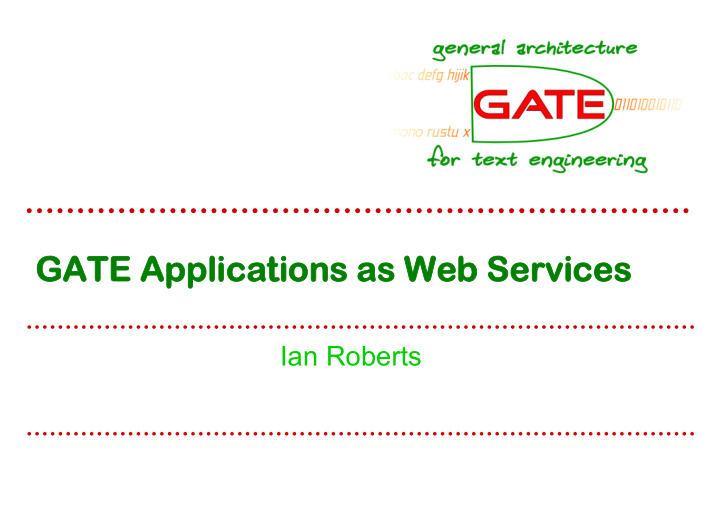



GATE Applications as W ATE Applications as Web Services eb Services Ian Roberts
University of Sheffield NLP Introduction Introduction • Scenario: Implementing a web service (or other web application) that uses GATE Embedded to process requests. Want to support multiple concurrent requests Long running process - need to be careful to avoid memory leaks, etc. • Example used is a plain HttpServlet Principles apply to other frameworks (struts, Spring MVC, Metro/CXF, Grails…)
University of Sheffield NLP Setting up Setting up • GATE libraries in WEB-INF/lib gate.jar + JARs from lib • Usual GATE Embedded requirements: A directory to be "gate.home" Site and user config files Plugins directory Call Gate.init() once (and only once) before using any other GATE APIs
University of Sheffield NLP Initialisation using a Initialisation using a ServletContextListener ServletContextListener • ServletContextListener is registered in web.xml <listener> <listener-class>gate.web..example.GateInitListener</listener-class> </listener> • Called when the application starts up public void contextInitialized(ServletContextEvent e) { ServletContext ctx = e.getServletContext(); File gateHome = new File(ctx.getRealPath("/WEB-INF")); Gate.setGateHome(gateHome); File userConfig = new File(ctx.getRealPath("/WEB-INF/user.xml")); Gate.setUserConfigFile(userConfig); // site config is gateHome/gate.xml // plugins dir is gateHome/plugins Gate.init(); }
University of Sheffield NLP GATE in a m ATE in a multithreaded ultithreaded environm environment ent • GATE PRs are not thread-safe Due to design of parameter-passing as JavaBean properties • Must ensure that a given PR/Controller instance is only used by one thread at a time
University of Sheffield NLP First attem First attempt: one instance pt: one instance per request per request • Naïve approach - create new PRs for each request public void doPost(request, response) { ProcessingResource pr = Factory.createResource(...); try { Document doc = Factory.newDocument(getTextFromRequest(request)); try { // do some stuff } finally { Factory.deleteResource(doc); } } Many levels of nested try/finally: ugly but finally { necessary to make sure we clean up even Factory.deleteResource(pr); when errors occur. You will get very used to } these… }
University of Sheffield NLP Problem Problems w s with this approach ith this approach • Guarantees no interference between threads • But inefficient, particularly with complex PRs (large gazetteers, etc.) • Hidden problem with JAPE: Parsing a JAPE grammar creates and compiles Java classes Once created, classes are never unloaded Even with simple grammars, eventually OutOfMemoryError (PermGen space)
University of Sheffield NLP Second attem Second attempt: using pt: using ThreadLocals ThreadLocals • Store the PR/Controller in a thread local variable private ThreadLocal<CorpusController> controller = new ThreadLocal<CorpusController>() { protected CorpusController initialValue() { return loadController(); } }; private CorpusController loadController() { //... } public void doPost(request, response) { CorpusController c = controller.get(); // do stuff with the controller }
University of Sheffield NLP Better than attem Better than attempt 1 pt 1… • Only initialise resources once per thread • Interacts nicely with typical web server thread pooling • But if a thread dies, no way to clean up its controller Possibility of memory leaks
University of Sheffield NLP A solution: object pooling A solution: object pooling • Manage your own pool of Controller instances • Take a controller from the pool at the start of a request, return it (in a finally!) at the end • Number of instances in the pool determines maximum concurrency level
University of Sheffield NLP Sim Simple exam ple example ple private BlockingQueue<CorpusController> pool; public void init() { pool = new LinkedBlockingQueue<CorpusController>(); for(int i = 0; i < POOL_SIZE; i++) { pool.add(loadController()); } } public void doPost(request, response) { CorpusController c = pool.take(); Blocks if the pool is empty: use try { poll() if you want to handle empty // do stuff pool yourself } finally { pool.add(c); } } public void destroy() { for(CorpusController c : pool) Factory.deleteResource(c); }
University of Sheffield NLP Further reading Further reading • Spring Framework http://www.springsource.org/ Handles application startup and shutdown Configure your business objects and connections between them using XML GATE provides helpers to initialise GATE, load saved applications, etc. Built-in support for object pooling Web application framework (Spring MVC) Used by other frameworks (Grails, CXF, …)
University of Sheffield NLP Conclusions Conclusions • Only use GATE Resources in one thread at a time • Make sure to clean up after yourself, even when things go wrong try/finally Whenever you createResource, be sure to deleteResource
Recommend
More recommend